
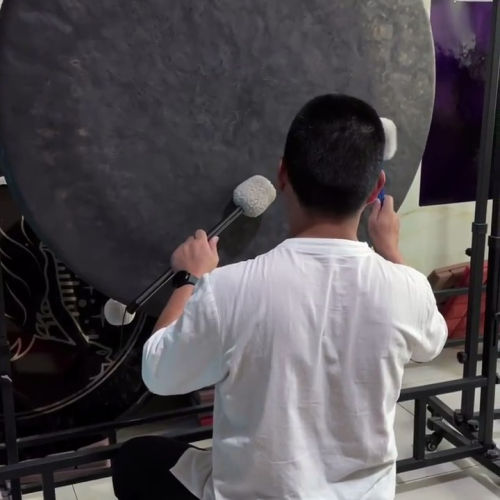
Playing the gong is an ancient art that bridges the physical and metaphysical worlds, transforming simple bronze into a gateway for profound healing experiences. When you first approach a gong with mallet in hand, you’re entering into a relationship that has been cultivated by sound healers for thousands of years. The instrument responds not just to the force of your strike, but to your intention, your breathing, and even your emotional state. This comprehensive guide will take you through every aspect of gong playing, from the fundamental techniques that create beautiful tones to the advanced methods that can facilitate deep therapeutic transformation.
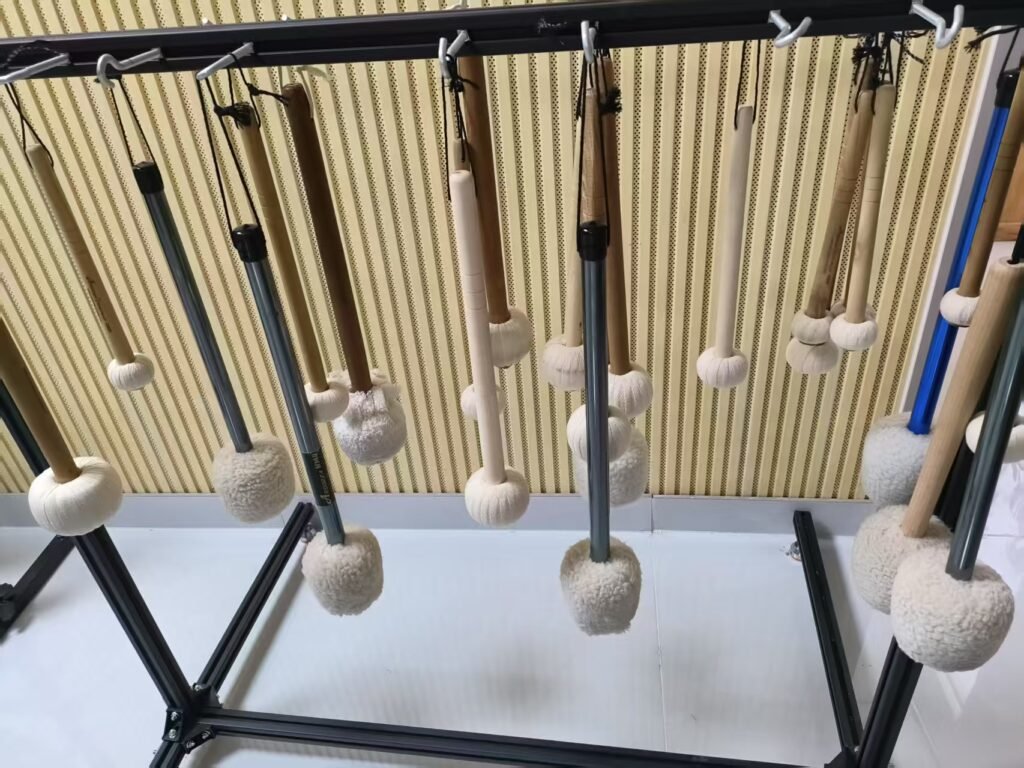
The journey into gong mastery begins with understanding how different mallets shape the voice of your instrument. When you hold a soft felt mallet, you’re choosing to work with the gong’s nurturing qualities. These mallets create sounds that seem to emerge from the bronze itself, starting as whispers and growing into warm embraces of sound. The felt wrapping cushions the impact, allowing the gong’s fundamental frequency to emerge clearly while encouraging the development of rich harmonic overtones that unfold over many seconds.
As you strike the gong with increasing firmness, you’ll notice how the felt mallet allows for incredible dynamic control. You can create sounds so subtle they’re felt more than heard, or build to powerful crescendos that fill the largest spaces with healing vibration. The beauty of soft mallets lies in their forgiving nature – even beginners can create beautiful sounds immediately, while masters use them to craft nuanced therapeutic experiences that guide listeners through complex emotional landscapes.
Hard mallets tell a different story entirely. When you choose wood or rubber, you’re accessing the gong’s more dramatic personality. These tools create sounds with immediate presence and crystalline clarity. The initial attack cuts through ambient noise and mental chatter, demanding attention from everyone in the room. Hard mallets excel at creating pivotal moments in sound healing sessions – those powerful strikes that can shift energy, break through resistance, or mark important transitions in the therapeutic journey.
Between these extremes lies a world of specialized tools that expand your sonic palette infinitely. Friction mallets open the door to continuous sounds that seem to breathe with organic rhythm. As you roll these rubber-coated tools across the gong’s surface, you create sustained tones that evolve constantly, mimicking the natural world’s continuous cycles of change and renewal. Wire brushes add delicate textures reminiscent of rainfall or wind through leaves, perfect for creating atmospheric backgrounds that support deep meditation.
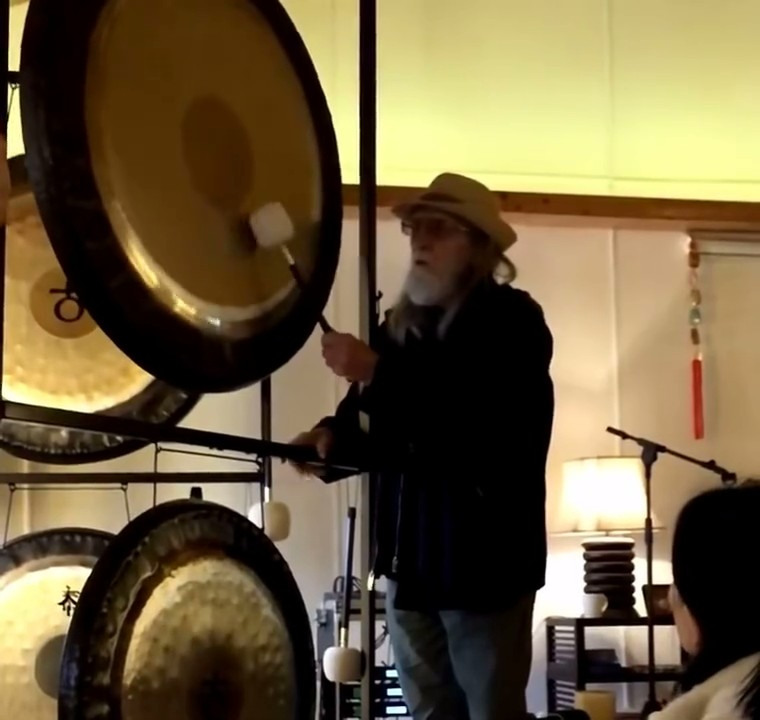
The relationship between gong and stand parallels that between musician and instrument – each must support the other for optimal performance. A quality stand becomes invisible during play, holding your gong securely while allowing complete freedom of vibration. The mounting system should contact the gong at minimal points, typically just the suspension holes, ensuring that no part of the stand dampens the instrument’s natural resonance.
Height adjustment capabilities prove essential as you develop your playing style. When the gong hangs at chest level, your arms move naturally through their full range, allowing you to access every zone of the instrument without strain. This positioning also optimizes sound projection, directing the acoustic energy toward your audience rather than the ceiling or floor. Many players discover that small adjustments in height dramatically affect both their comfort and the gong’s acoustic performance.
The acoustic environment surrounding your gong setup influences every sound you create. Positioning the instrument away from reflective surfaces prevents the confusion of overlapping sound waves that can muddy your carefully crafted tones. The space behind the gong proves equally critical, as the instrument’s back surface needs room to vibrate freely. Experienced players often test different positions within a room, noting how moving just a few feet can transform their gong’s voice entirely.
Every room tells its own acoustic story, and learning to work with rather than against these characteristics elevates your gong playing immeasurably. Spaces with moderate reverberation become partners in your sound creation, adding natural delay and harmonic enhancement that makes even simple strikes sound professionally polished. The ideal acoustic environment provides enough reflection to add richness without creating muddiness or unwanted echoes.
Temperature and humidity subtly but significantly affect bronze instruments. Warmer temperatures encourage the metal to resonate more freely, while excessive cold can make the gong sound tight and constrained. Humidity levels impact not only the longevity of your instrument but also its immediate response characteristics. Many professional players keep detailed notes about how their gongs perform under different environmental conditions, developing the sensitivity to adjust their technique accordingly.
The visual environment contributes to the overall healing experience as much as the acoustic one. Soft lighting helps participants relax and turn inward, while harsh fluorescent bulbs can maintain mental alertness that works against the meditative states you’re trying to encourage. Even small details like air circulation and ambient scents contribute to creating the optimal container for sound healing work.
Responsible gong playing requires constant awareness of how sound affects the nervous system. The powerful vibrations that make gongs so effective for healing can also overwhelm sensitive individuals if applied without proper consideration. Beginning every session with gentle, quiet tones allows participants’ auditory systems to adjust gradually while you assess their comfort levels and responsiveness.
Volume management becomes an art form that distinguishes skilled practitioners from mere gong strikers. The most profound healing often occurs at moderate volume levels where participants can surrender to the sound without feeling assaulted by it. Learning to read subtle signs of discomfort in your audience – tension in facial expressions, changes in breathing patterns, or restless body movements – helps you adjust your playing in real time.
Certain medical conditions require special consideration when planning gong sessions. Pregnancy, heart conditions, and hearing sensitivities may necessitate modified approaches or exclusion from intense sound work entirely. Developing relationships with healthcare providers who understand sound therapy helps you make informed decisions about appropriate applications for different populations.
The art of striking a gong properly begins with understanding that you’re not hitting an object but rather initiating a conversation with a living instrument. When you approach the center of your gong with mallet raised, you’re preparing to awaken the fundamental frequency that gives the instrument its primary voice. The center strike requires a balance of confidence and gentleness – enough force to fully activate the bronze but not so much that you create harsh overtones or stress the metal.
The moment of contact between mallet and gong should feel like a brief handshake rather than a violent collision. Allow the mallet to bounce naturally off the surface, trusting the gong’s responsiveness rather than forcing the interaction. This natural rebound prevents the mallet from dampening the very vibrations you’re trying to create while ensuring clean, clear tone production.
Moving away from the center opens entirely new tonal territories. Each position on the gong’s surface produces unique harmonic characteristics, creating a map of sonic possibilities that you’ll spend years exploring fully. Strikes near the rim generate brighter, more metallic tones with faster attack and quicker decay, perfect for adding sparkle or creating attention-grabbing moments. Mid-radius strikes offer rich overtone development that many healers find ideal for general therapeutic work.
The way you hold your mallet influences every aspect of sound production, from tonal quality to dynamic control. A proper grip feels natural and relaxed, similar to holding a pencil but with slightly more security. Your fingers should curve gently around the handle, maintaining contact without creating tension that would interfere with fluid movement. The thumb and index finger provide primary control, while the remaining fingers offer support and stability.
Wrist flexibility proves crucial for developing smooth, flowing strikes. A rigid wrist creates choppy, mechanical-sounding attacks that lack the organic quality essential for healing work. Practice rotating your wrist gently as you strike, allowing the movement to flow from your shoulder through your arm to your hand. This full-body involvement creates strikes that feel effortless and produce sounds with natural, breathing qualities.
Your relationship with the gong extends beyond just the striking hand. Your entire posture contributes to the quality of sound you create. Standing with feet firmly planted but not rigid provides stability without tension. Your non-striking hand can rest naturally at your side or be used expressively to help guide your intention and energy toward the instrument.
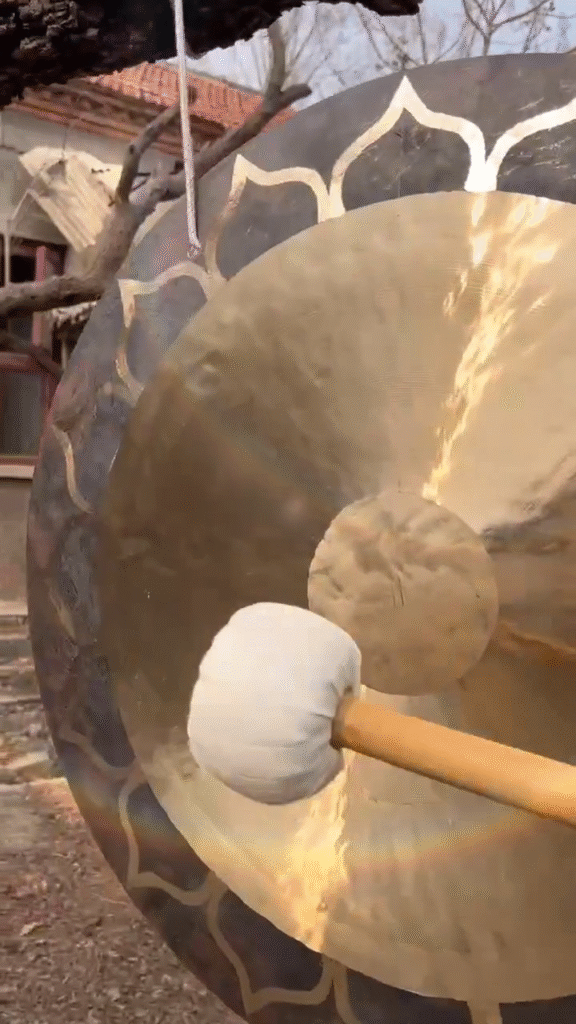
Every gong possesses its own unique geography of sound, with different zones producing distinctly different tonal characteristics. Learning this geography becomes one of the most rewarding aspects of developing your relationship with a particular instrument. The center zone typically produces the purest expression of the gong’s fundamental frequency, offering balanced harmonics and sustained resonance that forms the backbone of most healing work.
As you explore outward from center, you discover how the harmonic content shifts and evolves. The mid-radius area often proves richest in complex overtones, creating sounds that seem to contain entire orchestras of subtle frequencies. These zones excel for deep therapeutic work where you want to envelope listeners in layers of harmonic complexity that encourage profound relaxation and introspection.
The outer regions near the rim provide contrast and excitement, generating bright, attention-getting tones that can punctuate longer passages or signal transitions in your sound journey. Learning to move fluidly between different zones creates dynamic interest while allowing you to match your playing to the evolving needs of your session.
Mastering dynamic control transforms simple strikes into nuanced musical statements. Soft playing requires as much skill as loud playing, perhaps more, because subtle sounds demand perfect technique to achieve clarity and projection. When you strike gently, focus on clean contact and complete follow-through, trusting that the gong will respond proportionally to your input.
Building intensity gradually creates powerful therapeutic experiences that guide listeners through emotional and energetic shifts. Start with barely audible tones that seem to emerge from silence itself, then increase volume and complexity systematically. This approach respects the nervous system’s need for gradual adaptation while creating dramatic arcs that can facilitate profound transformation.
Timing variations add another dimension to your sonic palette. Single strikes with complete resonance decay allow each sound to be fully experienced and integrated before new frequencies are introduced. Rhythmic patterns can create entrainment effects that help synchronize brain waves and breathing patterns among participants. Random, intuitive timing feels most organic and prevents the analytical mind from predicting and categorizing your sounds.
Select a gong for your own use

https://dorhymigroup.com/product-category/gong
The rim of your gong offers entirely different expressive possibilities from the main playing surface. When you strike the edge with precision and authority, you access bell-like tones that cut through complex harmonic textures with crystalline clarity. These sounds carry symbolic power in many traditions, representing moments of awakening, transition, or divine communication.
Developing consistent rim technique requires practice and patience. The edge provides a much smaller target than the main surface, demanding accuracy and confidence in your striking motion. Start with moderate force to avoid damaging the gong while learning proper contact points and angles. Harder mallets generally work best for rim shots, creating the sharp attack and bright timbre that make these techniques so effective.
Scraping techniques along the rim create sustained tones that seem to emerge from another dimension. Draw your mallet along the edge with steady pressure and consistent speed, listening as continuous sound unfolds like an endless musical phrase. These techniques work beautifully for building tension, creating transitions between sections of a sound journey, or adding mysterious atmospheric elements to your playing.
Rolling transforms your gong from a percussion instrument into something more akin to a violin or cello, capable of producing continuous, evolving tones. The basic rolling motion involves moving your mallet in consistent circles across the gong surface while maintaining steady pressure. Start with large, slow circles to establish the technique, then experiment with smaller patterns and varying speeds.
The pressure you apply while rolling determines both volume and tonal character. Light pressure creates ethereal, floating sounds that seem to hover in space, while firmer pressure generates more substantial tones with greater harmonic complexity. Learning to modulate pressure smoothly allows you to create crescendos and diminuendos that breathe with organic rhythm.
Advanced rolling techniques involve multiple mallets, figure-eight patterns, and combinations of rolling with traditional strikes. These methods create complex soundscapes where multiple layers of continuous tone interact with punctuated accents, producing music that feels both ancient and futuristic. Such techniques require significant practice but offer unlimited creative possibilities for experienced players.
Friction techniques open portals to otherworldly sounds that seem to come from beyond the physical instrument. Using specialized gong bows or modified mallets, you can draw continuous tones from the bronze surface that sustain indefinitely with proper technique. These sounds often produce profound meditative states because they bypass the attack-and-decay pattern that characterizes most percussion instruments.
Learning to bow a gong properly requires understanding how to apply consistent pressure while moving at steady speed. Too much pressure creates scratchy, unpleasant sounds, while too little fails to generate sufficient vibration. The sweet spot produces clear, singing tones that seem to emerge from the metal itself. Practice with different bow materials and techniques until you find approaches that feel natural and produce beautiful results.
Combining friction techniques with traditional striking creates fascinating textural contrasts. You might begin a passage with gentle bowing to establish a sustained harmonic foundation, then add struck accents that bloom against this continuous background. Such combinations demonstrate the gong’s incredible versatility while creating sophisticated musical experiences that engage listeners on multiple levels simultaneously.
Creating complex harmonic structures through careful layering represents one of the most advanced aspects of gong playing. When you strike different zones in carefully timed sequence, allowing each tone to develop while adding complementary frequencies, you build harmonic architectures that can support profound healing experiences. This technique requires deep listening skills and understanding of how different frequencies interact.
Successful layering depends on timing that allows each new tone to enhance rather than conflict with existing vibrations. Strike the first zone and listen carefully as the harmonics develop, then add the second tone at the moment when it will create the most beautiful interaction. This process cannot be rushed or mechanized – it requires intuitive sensitivity and willingness to respond to what you hear in real time.
Multiple gong coordination expands layering possibilities exponentially. When you have access to gongs of different sizes and tunings, you can create symphonic experiences that would be impossible with a single instrument. Develop coordination between your hands so you can play multiple gongs simultaneously, creating call-and-response patterns or harmonic interactions that showcase each instrument’s unique voice while building unified musical statements.
Gong playing for meditation requires sensitivity to the delicate mental states you’re trying to support and deepen. Contemplative practices work best with sounds that encourage inward attention without creating distraction or overstimulation. Begin meditation sessions with soft, simple tones that establish peaceful atmosphere while allowing participants to settle naturally into quiet awareness.
The irregular timing that works beautifully for meditation prevents the mind from anticipating and categorizing sounds, keeping attention fresh and present. Strike your gong when inspiration moves you rather than following predetermined patterns, allowing silence between strikes to be as important as the sounds themselves. This approach mirrors the natural rhythms of breath and consciousness while avoiding the mechanical quality that can make sessions feel clinical rather than sacred.
Rolling techniques prove invaluable for supporting deep meditative states because they provide continuous sound that participants can ride like a river of vibration. The constant tone eliminates the mental activity that often accompanies anticipating the next strike while creating acoustic environments that seem to exist outside normal time. Practice maintaining rolls for extended periods, developing the stamina and consistency needed for longer meditation sessions.
Group sessions require different considerations from individual work because you’re managing multiple nervous systems simultaneously while creating shared experiences that can accommodate varying levels of sensitivity and experience. Begin group sound baths with familiar, comforting tones that help anxious participants relax while establishing your credibility with more experienced listeners.
Reading group energy becomes essential for responsive playing that serves the collective need rather than following predetermined plans. Watch for signs of engagement, resistance, or overwhelm among participants, adjusting your volume, timing, and technique accordingly. Some groups need gentle, nurturing sounds throughout, while others can handle more dynamic ranges that include powerful climaxes and dramatic contrasts.
Creating shared journeys through structured playing helps groups move through collective experiences that individual practice might not access. Build your sessions with clear beginnings that gather attention, developmental middle sections that explore different territories, and satisfying conclusions that help participants integrate their experiences. This narrative approach gives groups something to hold onto while surrendering to the unknown territories that sound healing can reveal.
Working with chakra frequencies requires understanding both the traditional associations between different tones and body energy centers and the individual variations that make each person’s energetic system unique. Planet gongs tuned to specific frequencies offer one approach to this work, but learning to sense energetic responses to different sounds proves more important than rigid adherence to prescribed frequencies.
Begin chakra work with grounding sounds that help establish energetic stability before moving to higher centers. Lower-pitched gongs and deeper zones of your instrument generally support root chakra activation, while higher frequencies correspond to upper chakras. Move systematically through the energetic system, spending time at each level while observing how participants respond to different tonal qualities.
Integration proves as important as activation in effective chakra work. After exploring the full spectrum of energetic centers, conclude with heart-centered tones that help balance and unify the entire system. Many practitioners find that sounds generated from the gong’s central zones work beautifully for this integrative work because they naturally combine fundamental frequencies with rich harmonic development.
Designing gong sessions specifically for stress relief requires understanding how the nervous system responds to different acoustic environments. Chronic stress keeps the nervous system in states of hypervigilance that make sudden sounds startling rather than soothing. Begin stress relief sessions with predictable, gentle rhythms that help anxious systems begin relaxing their defensive patterns.
Temperature regulation often accompanies stress relief as the nervous system shifts from sympathetic to parasympathetic dominance. Warm, enveloping tones seem to support this transition most effectively, encouraging the deep breathing and muscular relaxation that characterize healthy stress recovery. Focus on creating acoustic environments that feel safe and nurturing rather than challenging or transformative.
Progressive relaxation through sound works by systematically reducing stimulation while maintaining just enough interest to prevent mental restlessness. Start with moderately engaging playing that captures attention, then gradually decrease complexity and volume while increasing the spaces between sounds. This approach guides participants into deeper states naturally without forcing or manipulating their responses.
Masterful crescendos feel inevitable and organic rather than forced or mechanical. Begin with sounds so subtle they seem to emerge from silence itself, then build intensity through careful attention to pacing and proportion. Each increase in volume should feel natural and necessary, creating momentum that carries listeners forward while maintaining their comfort and engagement.
The secret to effective crescendos lies in using multiple parameters simultaneously rather than simply increasing volume. As sounds grow louder, you might also increase harmonic complexity, add additional gongs, or incorporate different playing techniques. This multi-dimensional approach creates richness and interest that keeps powerful passages from feeling overwhelming or one-dimensional.
Diminuendos require equal skill and attention because reducing intensity gracefully prevents sessions from ending abruptly or awkwardly. Practice controlling volume decreases smoothly while maintaining tonal quality and musical interest. The final sounds of a session often prove most memorable because they’re what participants carry with them as they return to ordinary consciousness, making masterful diminuendos essential for satisfying conclusions.
Effective timing in sound healing serves therapeutic rather than musical goals, though the two often overlap in beautiful ways. Unlike musical performance where rhythm provides structure and momentum, therapeutic timing seeks to match and guide natural physiological rhythms like breathing and heart rate. This requires sensitivity to collective group rhythms as well as your own internal sense of appropriate pacing.
Breathing synchronization creates powerful entrainment effects that can help groups achieve coherent meditative states. Watch for collective breathing patterns during sessions and time your strikes to support natural inhalation and exhalation cycles. Sounds that emerge during exhalation often feel most satisfying because they align with the natural release and letting-go that characterizes healthy breathing.
Avoiding mechanical timing keeps sessions feeling alive and responsive rather than predetermined. While some structure helps both you and participants navigate sound journeys successfully, too much predictability can engage analytical thinking that works against meditative states. Practice playing with organic timing that feels natural and flowing while maintaining enough consistency to create coherent experiences.
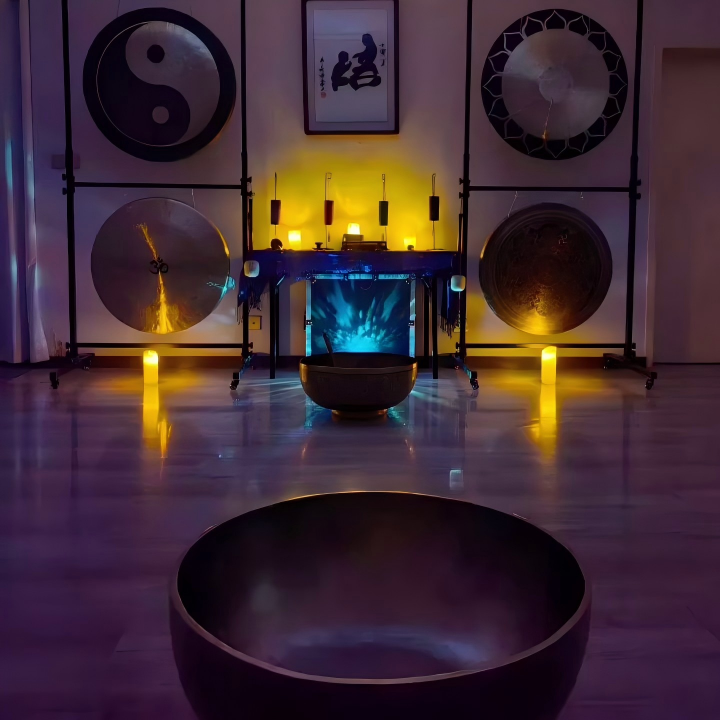
Orchestrating multiple gongs requires understanding how different frequencies interact harmonically while developing the physical coordination needed to move between instruments fluidly. Start with simple alternation between two gongs of contrasting sizes, noting how their different voices create dialogue and conversation. This call-and-response approach feels natural and provides excellent training for more complex multi-gong work.
Harmonic relationships between different gongs can create either beautiful resonance or muddy interference depending on your choices and timing. Gongs tuned to related frequencies often produce beating patterns and harmonic enhancement when played together, while unrelated frequencies might create confusion if not handled skillfully. Experiment systematically with different combinations to learn which pairings work best for your instruments and intentions.
Spatial considerations become important when working with multiple gongs because sound waves from different instruments interact differently depending on positioning and room acoustics. Arrange your gongs to optimize both your movement between them and the acoustic interactions they create. Some players prefer symmetrical arrangements that create stereo effects, while others use asymmetrical positioning to create more complex soundscapes.
Developing sensitivity to participant responses transforms good gong players into exceptional sound healers. Learn to observe breathing patterns, body language, and energy levels throughout sessions, adjusting your playing to serve what you observe rather than following predetermined plans. This responsive approach requires confidence in your abilities and willingness to trust intuitive guidance over mechanical execution.
Different groups require different approaches based on their experience levels, intentions, and collective energy. Corporate stress-relief sessions might need gentler, more predictable approaches than workshops for experienced meditators who can handle more challenging or transformative sound experiences. Develop flexibility in your approach while maintaining authenticity in your own playing style.
Signs of overwhelm or under-stimulation become clear once you know what to watch for. Restlessness, tension, or emotional distress might indicate that your playing is too intense or challenging for current participants. Conversely, distraction, sleepiness, or lack of engagement might suggest that you need to increase interest or intensity to maintain therapeutic effectiveness. Practice making smooth adjustments that address these issues without disrupting the overall flow of your sessions.
The most common error among beginning gong players involves confusing volume with effectiveness, leading to overwhelming sessions that assault rather than heal nervous systems. Powerful healing often occurs at moderate volume levels where participants can surrender to sound without feeling threatened by it. Developing sensitivity to appropriate volume for different spaces, group sizes, and therapeutic intentions requires experience and careful attention to participant responses.
Learning restraint proves more challenging than learning technique for many players because the gong’s dramatic power can be intoxicating. The instrument’s ability to fill large spaces with overwhelming sound can tempt players to prioritize spectacle over healing effectiveness. Practice playing at various dynamic levels consistently, developing confidence in gentle approaches that might feel less impressive but often prove more therapeutically valuable.
Silence integration separates skillful practitioners from enthusiastic beginners. The spaces between sounds provide opportunities for integration and absorption that continuous playing cannot offer. Learn to be comfortable with extended silence during sessions, trusting that participants need time to process and integrate the sounds you provide rather than constant stimulation.
Mechanical timing creates predictable patterns that engage analytical thinking rather than supporting meditative states. While some rhythmic structure can be helpful, overly regular patterns encourage mental anticipation that works against the present-moment awareness that characterizes effective healing sessions. Practice organic timing that feels natural and flowing while avoiding both mechanical repetition and chaotic randomness.
Rushing between sounds prevents full development and appreciation of each tone you create. The gong’s rich harmonic content needs time to unfold completely, and cutting this process short diminishes the therapeutic impact of your playing. Learn patience in allowing complete sound cycles from initial attack through full harmonic development to natural decay.
Ignoring natural rhythms in favor of predetermined patterns misses opportunities for entrainment and synchronization that can enhance therapeutic effectiveness. Breath rhythms, heart rates, and collective group energy all provide guidance for appropriate timing if you develop sensitivity to these subtle influences. Practice playing responsively rather than mechanically, allowing natural rhythms to guide your timing choices.
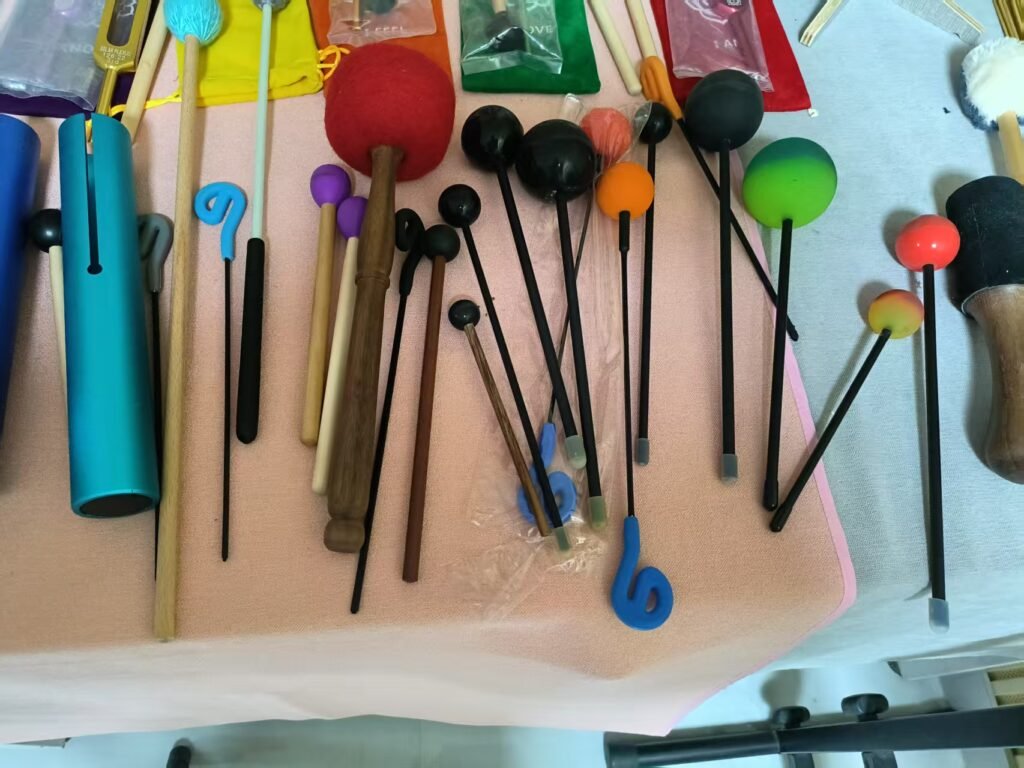
Using inappropriate mallets for intended effects creates frustration and limits therapeutic potential. Hard mallets during gentle healing sessions can feel jarring and unsettling, while soft mallets during dynamic group work might lack sufficient presence and clarity. Develop familiarity with how different mallets affect your gong’s voice and match your tool selection to session intentions and participant needs.
Failing to have multiple mallet options available during sessions limits your ability to respond appropriately to changing needs and unexpected developments. Professional sound healers typically work with several different mallets within easy reach, allowing smooth transitions between different tonal qualities as sessions evolve. Practice switching between mallets gracefully without disrupting session flow.
Neglecting mallet maintenance affects both sound quality and instrument longevity. Worn or damaged mallets can create harsh or inconsistent sounds while potentially damaging gong surfaces. Inspect your mallets regularly and replace them as needed to maintain professional standards and protect your valuable instruments.
Treating silence as empty time rather than active therapeutic space represents a fundamental misunderstanding of sound healing principles. The pauses between sounds provide opportunities for integration and absorption that continuous playing cannot offer. Learn to use silence strategically, allowing adequate time for each sound to be fully experienced before introducing new elements.
Rushing to fill every moment with sound prevents the development of spaciousness and receptivity that characterize deep healing states. Participants often need time to process and integrate the vibrational experiences you provide, and constant stimulation can overwhelm rather than support this natural processing. Practice comfortable silence that feels intentional rather than awkward or uncertain.
Failing to create appropriate acoustic space through room arrangement and positioning limits your gong’s natural resonance and projection capabilities. Sound waves need room to develop and interact with environmental factors that enhance rather than diminute therapeutic effectiveness. Consider acoustic factors when setting up practice and session spaces to optimize the healing potential of your work.
Establishing consistent practice habits accelerates skill development while deepening your relationship with the instrument. Technical practice should include work on basic striking techniques, dynamic control, and mallet coordination. Spend time each day focusing on clean, consistent strikes at various volume levels, developing the muscle memory and sensitivity needed for responsive playing during sessions.
Musical development practice involves creating coherent sound journeys that demonstrate narrative structure and emotional arc. Work on smooth transitions between different techniques and zones while building your repertoire of effective approaches for various therapeutic applications. Record these practice sessions periodically to track progress and identify areas needing attention.
Contemplative practice with your gong develops the meditative awareness and intuitive sensitivity that distinguish exceptional sound healers from mere technicians. Spend time simply listening to your instrument’s voice, exploring its harmonic characteristics and learning to sense the subtle energy patterns that accompany different sounds. This meditative approach to practice cultivates the presence and awareness needed for truly responsive therapeutic work.
Documenting your playing through regular recordings provides objective feedback that supplements subjective self-evaluation. What feels powerful and effective from the player’s perspective might sound quite different from the participant’s position, and recordings help you understand these perceptual differences. Listen critically to your recorded sessions, noting areas where technique, timing, or dynamics could be improved.
Analyzing your recordings over time reveals patterns in your playing that might not be apparent during live sessions. You might discover tendencies toward rushing, repetitive patterns, or volume levels that don’t serve therapeutic goals. This analytical approach to self-improvement accelerates development by making unconscious habits conscious and addressable.
Sharing recordings with mentors and experienced colleagues provides valuable outside perspective on your development. Other practitioners can often identify strengths and weaknesses that you might miss while offering suggestions for improvement based on their own experience. Build relationships with other sound healers who can provide honest, constructive feedback on your recorded work.
Studying with experienced teachers accelerates learning while helping you avoid common pitfalls and development dead-ends. Seek instruction from practitioners who demonstrate both technical excellence and therapeutic effectiveness, paying attention to how they integrate skillful means with compassionate intention. Workshop attendance and intensive training programs provide immersive learning experiences that cannot be replicated through solo practice.
Observation skills prove as important as direct instruction in learning from masters. Watch how experienced players hold their bodies, move between techniques, and respond to participant energy during live sessions. Note their use of silence, timing, and volume in creating therapeutic effects. Many subtleties of masterful practice can only be learned through careful observation of skilled practitioners in action.
Building relationships within the sound healing community provides ongoing support and learning opportunities throughout your development. Regular interaction with other practitioners helps you stay current with developments in the field while providing opportunities for collaboration and mutual support. Professional associations and online communities offer valuable resources for continuing education and networking.
Formal training programs provide structured learning experiences that can accelerate development while ensuring comprehensive foundation knowledge. Look for programs that combine technical instruction with therapeutic applications, anatomy and physiology education, and supervised practice opportunities. Accredited programs typically offer more rigorous training and better professional recognition than informal workshops.
Continuing education requirements in many certification programs encourage ongoing development and learning throughout your career. Stay current with research developments in sound healing, neuroscience, and related fields that inform best practices and therapeutic applications. Regular workshop attendance and advanced training help you refine your skills while expanding your knowledge base.
Professional standards and ethical guidelines become increasingly important as sound healing gains mainstream acceptance and integration with conventional healthcare. Understand scope of practice limitations, contraindications for different populations, and appropriate referral procedures for situations beyond your training and competence. Professional certification programs typically address these issues comprehensively while providing ongoing guidance for ethical practice.
The path to mastering gong playing for healing purposes unfolds gradually through patient practice, careful study, and genuine dedication to serving others through sound. While technical proficiency provides the foundation for effective work, the deeper aspects of sound healing emerge through developing sensitivity, presence, and compassionate intention that transform simple strikes into profound therapeutic experiences.
Every gong carries within its bronze structure the accumulated wisdom of countless craftspeople, players, and healing recipients throughout history. When you approach your instrument with respect and genuine desire to facilitate healing, you join this ancient lineage while contributing your own unique voice to the continuing evolution of sound therapy. The techniques and principles outlined in this guide provide roadmaps for development, but your personal journey will be uniquely yours.
Remember that becoming an effective sound healer involves much more than learning to strike a gong skillfully. The most powerful sessions emerge when technical competence serves deeper qualities of presence, compassion, and intuitive wisdom. Cultivate these inner qualities alongside your external skills, understanding that your own healing and development directly impact your ability to serve others effectively.
The gong teaches patience above all else. Each strike requires time to develop its full harmonic potential, each session needs space to unfold naturally, and each practitioner must allow years for deep mastery to emerge. Trust in this natural timeline while maintaining consistent practice and openness to learning. Your dedication to this ancient art form will be rewarded with the profound satisfaction that comes from facilitating genuine healing through the transformative power of sound.
As you continue developing your practice, remain curious about the mysteries that surround sound healing while building confidence in the techniques and principles that create reliable therapeutic effects. The balance between knowledge and wonder, skill and spontaneity, structure and flow characterizes the most effective sound healing work. Your journey with the gong will teach you not only how to create beautiful sounds but also how to serve as a clear channel for the healing potential that exists within vibration itself.


2 Responses